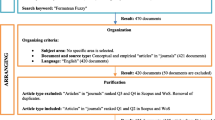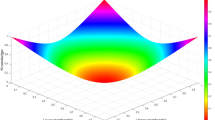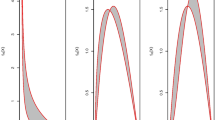Abstract
As a further generalization of the concepts of fuzzy set, intuitionistic fuzzy set, single valued neutrosophic refined set, hesitant fuzzy set, and dual hesitant fuzzy set, Ye (J Intell Syst 24(1):23–36, 2015) proposed the concept of hesitant neutrosophic sets (also called single valued neutrosophic hesitant fuzzy sets). Following the idea of hesitant neutrosophic sets as introduced by Ye, in this paper, the model of hesitant neutrosophic rough sets is proposed, then the join semi-lattice structure of lower and upper hesitant neutrosophic rough approximation operators over two universes is given. In addition, an algorithm to handle decision making problem in medical diagnosis based on hesitant neutrosophic rough sets over two universes is provided. Finally, a numerical example is employed to demonstrate the validness of the proposed hesitant neutrosophic rough sets.
Similar content being viewed by others
References
Atanassov K (1986) Intuitionistic fuzzy sets. Fuzzy Sets Syst 20(1):87–96
Bao YL, Yang HL (2017) On single valued neutrosophic refined rough set model and its applition. J Intell Fuzzy Syst 33(2):1235–1248
Biswas P, Pramanik S, Giri BC (2016) GRA method of multiple attribute decision making with single valued neutrosophic hesitant fuzzy set information. In: Smarandache F, Pramanik S (eds) New trends in neutrosophic theory and applications. Pons Editions, Brussels, pp 55–63
Bo CX, Zhang XH, Shao ST, Smarandache F (2018) Multi-granulation neutrosophic rough sets on a single domain and dual domains with applications. Symmetry. https://doi.org/10.3390/sym10070296
Broumi S, Smarandache F (2014) Rough neutrosophic sets. Ital J Pure Appl Math 32:493–502
Guo Y, Cheng HD (2009) A new neutrosophic approach to image segmentation. Pattern Recognit 42:587–595
Guo Y, Sengur A (2015) NCM: neutrosophic c-means clustering algorithm. Pattern Recognit 48(8):2710–2724
Khan Q, Mahmood T, Ye J (2017) Multiple attribute decision-making method under hesitant single valued neutrosophic uncertain linguistic environment. J Inequal Spec Funct 8(2):17
Li ZW, Cui RC (2015a) \(T\)-similarity of fuzzy relations and related algebraic structures. Fuzzy Sets Syst 275:130–143
Li ZW, Cui RC (2015b) Similarity of fuzzy relations based on fuzzy topologies induced by fuzzy rough approximation operators. Inf Sci 305:219–233
Li X, Zhang XH (2018) Single-valued neutrosophic hesitant fuzzy Choquet aggregation operators for multi-attribute decision making. Symmetry. https://doi.org/10.3390/sym10020050
Li ZW, Liu XF, Zhang GQ, NiX Xie, Wang SC (2017) A multi-granulation decision-theoretic rough set method for distributed fc-decision information systems: an application in medical diagnosis. Appl Soft Comput 56:233–244
Liu PD, Teng F (2017) Some interval-valued Neutrosophic hesitant fuzzy uncertain linguistic Bonferroni mean aggregation operators and their application in multiple attribute decision making. Int J Uncertain Quantif 7(6):525–572
Liu PD, Zhang LL (2017) An extended multiple criteria decision-making method based on neutrosophic hesitant fuzzy information. J Intell Fuzzy Syst 32(6):4403–4413
Mahmood T, Ye J, Khan Q (2016) Vector similarity measures for simplified neutrosophic hesitant fuzzy set and their applications. J Inequal Spec Funct 7(4):176–194
Majumdar P, Samant SK (2014) On similarity and entropy of neutrosophic sets. J Intell Fuzzy Syst 26(3):1245–1252
Pawlak Z (1982) Rough sets. Int J Comput Inform Sci 11:341–356
Şahin R, Küçük A (2015) Subsethood measure for single valued neutrosophic sets. J Intell Fuzzy Syst 29(2):525–530
Şahin R, Liu PD (2016) Correlation coefficient of single-valued neutrosophic hesitant fuzzy sets and its applications in decision making. Neural Comput Appl. https://doi.org/10.1007/s00521-015-2163-x
Salama AA, Broumi S (2014) Roughness of neutrosophic sets. Elixir Appl Math 74:26833–26837
Smarandache F (1998) Neutrosophy: neutrosophic probability, set, and logic. American Research Press, Rehoboth
Smarandache F (1999) A unifying field in logics. neutrosophy: neutrosophic probability, set and logic. American Research Press, Rehoboth
Smarandache F (2002) A unifying field in logics: neutrosophic logic. Int J Mult Valued Log 8(3): 385–438, ISSN: 1023–6627
Torra V (2010) Hesitant fuzzy sets. Int J Intell Syst 25:529–539
Torra V, Narukawa Y (2009) on hesitant fuzzy sets and decision. In: The 18th IEEE international conference on fuzzy systems. Jeju Island, pp 1378–1382
Xia MM, Xu ZS (2011) Hesitant fuzzy information aggregation in decision making. Int J Approx Reason 52:395–407
Xu ZS, Xia MM (2011) Distance and similarity measures for hesitant fuzy sets. inform. Sciences 181:2128–2138
Yang HL, Guo ZL, She YH, Liao XW (2016) On single valued neutrosophic relations. J Intell Fuzzy Syst 30:1045–1056
Yang HL, Zhang CL, Guo ZL, Liu YL, Liao XW (2017) A hybrid model of single valued neutrosophic sets and rough sets: single valued neutrosophic rough set model. Soft Comput 21(21):6253–6267
Ye J (2013) Multicriteria decision-making method using the correlation coefficient under single-valued neutrosophic environment. Int J Gen Syst 42(4):386–394
Ye J (2014) Improved correlation coefficients of single valued neutrosophic sets and interval neutrosophic sets for multiple attribute decision making. J Intell Fuzzy Syst 27:2453–2462
Ye J (2015) Multiple-attribute decision-making method using the under a single-valued neutrosophic hesitant fuzzy environment. J Intell Syst 24(1):23–36
Ye J (2016) Correlation coefficients of interval neutrosophic hesitant fuzzy sets and its application in a multiple attribute decision making method. Informatica 27(1):179–202
Ye J (2018) Multiple-attribute decision-making method using similarity measures of single-valued neutrosophic hesitant fuzzy sets based on least common multiple cardinality. J Intell Fuzzy Syst 34(6):4203–4211
Ye S, Ye J (2014) Dice similarity measure between single valued neutrosophic multisets and its applcation in medical diagnosis. Neutrosophic Sets Syst 6:48–53
Zhang C, Li DY, Mu YM, Song D (2016) An interval-valued hesitant fuzzy multigranulation rough set over two universes model for steam turbine fault diagnosis. Appl Math Modell. https://doi.org/10.1016/j.apm.2016.10.048
Zhang HD, Shu L, Liao SL (2017a) Hesitant fuzzy rough set over two universes and its application in decision making. Soft Comput 21(7):1803–1816
Zhang XH, Smarandache F, Liang XL (2017b) Neutrosophic duplet semi-group and cancellable neutrosophic triplet groups. Symmetry. https://doi.org/10.3390/sym9110275
Zhang XH, Bo CX, Smarandache F, Dai JH (2018a) New inclusion relation of neutrosophic sets with applications and related lattice structure. Int J Mach Learn Cybern 9:1753–1763
Zhang XH, Bo CX, Smarandache F, Park C (2018b) New operations of Totally dependent-neutrosophic sets and totally dependent-neutrosophic soft sets. Symmetry. https://doi.org/10.3390/sym10060187
Zhao H, Zhang HY (2018a) A result on single valued neutrosophic refined rough approximation operators. J Intell Fuzzy Syst 35:3139–3146
Zhao H, Zhang HY (2018b) Some results on multigranulation neutrosophic rough sets on a single domain. Symmetry. https://doi.org/10.3390/sym10090417
Author information
Authors and Affiliations
Corresponding author
Additional information
Publisher's Note
Springer Nature remains neutral with regard to jurisdictional claims in published maps and institutional affiliations.
The work is partly supported by the National Natural Science Foundation of China (Grant Nos. 11771263, 11671007), the Applied Basic Research Program Funded by Qinghai Province (Program No. 2019-ZJ-7078), the Scientific Research Program Funded by Shaanxi Provincial Education Department (Program No. 18JK0360), and the Doctoral Scientific Research Foundation of Xi’an Polytechnic University (Grant No. BS1426).
Rights and permissions
About this article
Cite this article
Zhao, H., Zhang, HY. On hesitant neutrosophic rough set over two universes and its application. Artif Intell Rev 53, 4387–4406 (2020). https://doi.org/10.1007/s10462-019-09795-4
Published:
Issue Date:
DOI: https://doi.org/10.1007/s10462-019-09795-4




